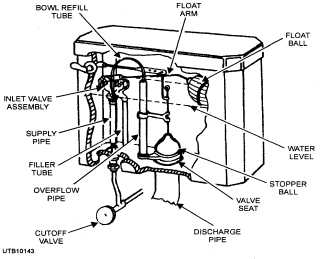WATER TANK FAILURES
Where a plumbing system has been in use for some time, two failures in water tanks are (1) leaky seams and (2) corroded areas requiring welded patch plates. To repair a defective seam, first drain the water tank dry. Then clean the surfaces to be repaired until they are right. By welding or brazing, you can then make the leaky portions watertight.
As an effective tank patch for a large hole, you need both a temporary and a permanent patch. One temporary patch is a tapered softwood plug. Insert the plug in the hole, and tap it lightly with a hammer until the seal is watertight. Then saw off the top of the plug, so it is flush with the tank wall.
Next, the area around the plug to be covered by the permanent patch should be cleaned by wire brushing. Drain the tank; now you are ready to apply the permanent patch. One type of permanent patch includes a rubber gasket and a metal plate. Rubber sheeting, at least 6 inches by 6 inches and l/16 inch thick, may be used for the gasket, and it should be centered on the plug and cemented with adhesive. The patch plate of black steel or nonferrous (no iron) metal should be of the same material and thickness as the tank wall but a lot larger than the hole. Cover the hole with the metal plate, keeping an equal overlap around the edges, and braze or weld the plate to the tank, using a continuous seam.
Q11. What is the most common reason a threaded pipe joint will leak?
Q12. Water tank failures normally occur due to what two causes?
WATER CLOSETS
LEARNING OBJECTIVE: Understand operation, maintenance, and repair of water closet flush tanks.
Moisture on the floor at the base of a water closet bowl usually means the seal or gasket between the closet and its outlet has failed; however, it can result from condensation on the tank or piping or from leakage of the tank, flush valve, or piping. When the seal leaks, remove the water closet bowl and install a new seal to prevent damage to the building. This also prevents entry of sewer gas into the room.
In servicing plumbing fixtures, you have the job of clearing stoppages in water closets. Information on tools and chemicals used in clearing stoppages in water closets and other fixtures is given later in this chapter.
FLUSH TANK
Knowing the principles of operation of a flush tank will enable you to find the source of trouble when a flush-type water closet tank is not operating properly. For clarity, all of the parts of a flush tank have been labeled in figure 5-41. Keep in mind that in different types of flush tanks you may find some change in the method of operation.
Table 5-4 explains the principle operation of a water closet flush tank. Simple though it may seem, you must understand the operation to troubleshoot an inoperative flush tank.
FLUSH TANK REPAIRS
When water continues to run into the closet bowl after the flush tank is full, the trouble is in some part of the inlet valve assembly (ball cock assembly) or the stopper valve is not seated. The plunger has failed to close the inlet valve as it should, and thus the excess water that continues to flow in (after the tank has reached the proper level) is being discharged through the overflow pipe and into the bowl.
In checking for the source of trouble, several defects to look for are a leak in the float ball, a bent float arm, a worn washer on the bottom of the plunger,

Figure 5-41. - Water closet flush tank.
Continue Reading